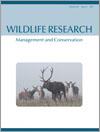Context Brazil has one of the richest biodiversity and one of the most extensive road networks in the world. Several negative impacts emerge from this interaction, including wildlife–vehicle collisions (WVC), which may represent a significant source of non-natural mortality in several species. The understanding of the main drivers of WVC is, therefore, crucial to improve the safe coexistence between human needs (transportation of goods and people) and animal populations.
Aims We aimed to (1) evaluate the relative influence of land-cover patterns on the distribution of WVC, (2) assess whether WVCs are clustered forming hotspots of mortality, and, if so, (3) evaluate the benefits of mitigating only hotspot sections.
Methods We collected WVC data involving medium–large mammals (4–260 kg) along three road transects (920 km), fortnightly over 1 year (n = 1006 records). We used boosted regression trees to relate the WVC locations with a set of environmental variables including a roadkill index, reflecting overall habitat suitability and landscape connectivity, while accounting for spatial autocorrelation effects. We identified hotspots of mortality using Ripley’s K statistic and testing whether data follow a random Poisson distribution correcting for Type I error.
Key results We found a strong association between WVC probability and roadkill index for all focal species. Distance to riparian areas, tree cover, terrain ruggedness and distance to urban areas were also important predictors, although to a lesser extent. We detected 21 hotspots of mortality, yet with little spatial overlapping as only four road sections (2%) were classified as hotspot for more than one species.
Conclusions Our results supported that WVC mainly occur in road sections traversing areas with more abundant and diverse mammal communities. Hotspots of mortality may provide important information to prioritise road sections for mitigation, but this should be used in complement with roadkill indexes accounting for overall mortality.
Implications The results support focusing on hotspots and habitat quality and landscape connectivity for a better assessment of road mortality. At the local scale, a larger number and improved road passages with exclusionary fencing of appropriate mesh size in riparian areas may provide safe crossings for many species and constitute a promising mitigation measure.





